AUCTORES
Globalize your Research
Research Article | DOI: https://doi.org/10.31579/2637-8914/261
Institute of Viticulture and Oenology, Eszterházy Károly Catholic University, HU-3300 Eger, Leányka street 12., Hungary.
*Corresponding Author: Zsuzsanna Bene, (2024), Impact of climate change on the (poly)phenol composition of botrytization in the Tokaj wine region, J. Nutrition and Food Processing, 7(11); DOI:10.31579/2637-8914/261
Citation: Zsuzsanna Bene, (2024), Impact of climate change on the (poly)phenol composition of botrytization in the Tokaj wine region, J. Nutrition and Food Processing, 7(11); DOI:10.31579/2637-8914/261
Copyright: © 2024, Zsuzsanna Bene. This is an open access article distributed under the Creative Commons Attribution License, which permits unrestricted use, distribution, and reproduction in any medium, provided the original work is properly cited.
Received: 23 August 2024 | Accepted: 02 September 2024 | Published: 16 September 2024
Keywords: botrytization; noble rot; phenolic acids; polyphenol; tokaj
Tokaj wine region is famous for its aszú wines, which are made of noble rotted raw materials. There is also a continuous change in the life activity of Botrytis cinerea as a result of climate change, which not only alters the rate of acidification but also its characteristic biochemical processes. Increasing sugar content is associated with a fructose excess, an increase in succinic acid, fumaric acid, citric acid, a change in the composition of phenolic compounds and an increase in phenolic acid content. This study examines the polyphenol content measured in the last 4 vintages and presents the typical phenolic acid composition.
Changes in the phenological cycles of plants, changes in the microclimate of regions with terroir that determines the organoleptic characteristics of wines, and an increase in the potential for severe weather events each year are just some of the effects of climate change (Bonnefoy et al., 2010). In regions where specific climatic conditions are very important for the development of berry necrosis, climate change can disrupt the microclimate, leading to drier or wetter seasons, which can affect the botrytis process (Agenis-Nevers, 2006).
The historical Tokaj region in northeast Hungary is an UNESCO World Heritage region since 2002 owning 5.500 ha vineyards. Produced from „noble rotted” grapes, Tokaji Aszú is known as one of the oldest botrytized wines all over the world (Magyar, 2011). Special microclimatic conditions (due to Bodrog and Tisza rivers, Indian summer), soil circumstances (clay, loess on volcanic bedrock) and grape-varieties (Furmint, Hárslevelű) of Tokaj-region offer favourable parameters to the formation of noble rot caused by Botrytis cinerea (Bene, 2004). The special metabolic activity of Botrytis results in noble rot grape called “aszú” berries. The grapes undergo complex chemical modifications as the joint result of the enzymatic activity of Botrytis and the physical process of concentration.
Sugar: The sugar content of the berry increases very significantly as a result of evaporation, resulting in an average must sugar content of 300 - 350 g/l (Donèche, 1989). The breakdown of polysaccharides and pectic substances increases the amount of other hexoses (rhamnose, galactose, mannose), pentoses (arabinose, xylose) and galacturonic acid (Dittrich&Grossmann, 2011; Magyar, 2011).
Polyols: three main polyols are responsible for the increased viscosity and "body" of wines with botrytis: butanediol, glycerol and sorbitol (Moreno&Peinado, 2012). Must from healthy grapes contains only traces of glycerol, but must from grapes with noble rot usually contains more than 5 g/l of glycerol (Dittrich&Sponholz, 1975). As the glycerol content continues to increase during fermentation, the glycerol content of wines made from raisined grapes is generally above 10 g/l, but often exceeds 20-30 g/l in Tokaj aszú (Magyar, 2011).
Acid composition: the activity of B. cinerea increases the amount of citric and succinic acids in the must, resulting in a particular acid composition in the wine. Tartaric acid, expressed in g/l, decreases by 55% in botrytised must and malic acid increases by 45%. Thus, the total acidity of around 8 g/l expressed as tartaric acid is almost unchanged compared with must from healthy grapes (Ribéreau-Gayon, 1982). Botrytis also produces certain acids (pectolytic, cellulose complex, protease and phospholipase) which were not originally present in the berry (gluconic, glucuronic, galactaric) (Ribéreau-Gayon et al., 2000). An increase in galacturonic acid content has also been observed in grapes infected by Botrytis (Dittrich&Sponholz, 1985, Doneche, 1993). Ketone acids (pyrosulfonic acid, 2-ketoglutaric acid) are present in increased concentrations as a result of noble rot (Bene, 2004).
Polysaccharides: the two main polysaccharides secreted by B. cinerea have different solubility in alcoholic solution (König et al., 2017). The first is a fairly soluble heteropolysaccharide consisting of 60% mannose, 30% galactose, 5% glucose, 5% rhamnose and a protein moiety. The other is botrytis glucan, a high molecular weight glucose polymer linked by β-D-position glycosidic bonds, less soluble in alcoholic solution and with a high impairment of filterability (Bene, 2004).
Free amino acids: The amount of free amino acids depends to a large extent on the vinification technology. In general, proline and arginine predominate, with very similar proportions of proline and arginine (30 and 28% respectively) in Tokaj specialities (Csomós, 2003).
Biogenic amines: The concentration of biogenic amines (tyramine, agmatine, phenylethylamine) and other amines (primary aliphatic amines: i-butylamine, 2-methylbutylamine) increases during the aszú production (Csomós, 2003; Kiss&Sass-Kiss, 2005).
Anti-inflammatory molecules: Kalló et al., 2020 isolated about 20 anti-inflammatory compounds in aszú wines: rhododendrin, caftaric acid, ethyl caffeate, chlorogenic acid, ethyl gallate, feraric acid, quercetin and taxifolin (phenolic compounds), asperlin, phenylalanine, bestatin, dodecanoic acid, histinidol, linamarin are among the most typical compounds.
Aroma compounds: Aroma compounds and other constituents: significant roles are played by furfural, benzaldehyde, a phenylacetaldehyde and benzaldehyde cyanohydrin (other name: prunasin-bitter almond flavour), as well as the so-called mushroom alcohol (1-octen-3-ol). Sotolon (3-Hydroxy-4,5-dimethylfuran-2(5H)- furanone) 3-hydroxy-4,5-dimethyl-2 (5H) furanone) produced by Botrytis cinerea is one of the most important components that gives the distinctive “Aszú” aroma (caramel flavour) (Ribéreau-Gayon et al., 2000). Botrytis increases the quantity of polyphenol oxidases that increase the tendency of the wine to browning, while polysaccharides (β-glucan) synthesis causes poor filterability of wines.
Polyphenols and phenolic acids: The effects of polyphenols on sensory properties have attracted increasing attention in recent times. Several studies (Costa et al., 2014; Shah et al., 2022; Rouxinol et al., 2023) have investigated the effects of increased temperature, UV radiation and drought on polyphenol content due to climate change. Costa et al., 2014 carried out studies in three different Portuguese regions (Alentejo, Douro and Dão) and found that high temperatures generally reduce berry weight, titratable acidity, total phenolic content, increase pH and potential alcohol. Shah et al., 2022 found that high temperatures impair phenolic biosynthesis pathways and therefore reduce their accumulation, while lower temperatures favour their production. High UV radiation can cause degradation of phenolic compounds. Water balance is also an important factor, as even a slight water deficit during the verasion period causes elevated levels. Rouxinol et el., 2023 examined red wines from Portugal (Alentejo) in two different vintages and the results show that polyphenol compounds vary from vintage to vintage. The reduction in berry size can cause results higher contents of polyphenolic compounds related to grape quality.
Achieving a level below the 200 mg/l threshold in the Tokaj wine region is a major challenge but certainly an aspiration for discerning winemakers. Previous research (Bene et al., 2023) has not demonstrated that an increase in polyphenol content can be detected as a result of climate change, but efforts to reduce polyphenol content are having an impact, with more and more samples achieving below 200 mg/l, especially for the Furmint grape variety.
Phenolic acids are an important group of non-flavonoid compounds present in grapes and wines that have attracted increasing interest over the past decade for their potential health benefits (e.g. antioxidant, antibacterial, antiviral, anticancer, anti-inflammatory and vasodilatory effects). Phenolic acids are predominantly composed of two subgroups: hydroxycinnamic acids (HCA) of the C6-C3 and C6-C1 types and hydroxybenzoic acids (HBA) (Monagas et al., 2005). HCA compounds constitute the major polyphenol content of white wines. Cinnamic acid derivatives without condensed skeleton (p-coumaric acid, ferulic acid, caftaric acid) are mostly present in the form of esters with tartaric acid (cutaric acid, ferulic acid, caftaric acid), of which caftaric acid (caffeyl tartrate) in particular is a preferred substrate for polyphenol oxidase enzymes in grapes. During the fermentation process, a partial hydrolysis of the esters takes place, the rate of which depends on pH and the presence of specific enzymes, free HCAs may be released and partially esterified with ethanol to form HCA ethyl esters. HCAs and their derivatives have antimicrobial properties, in particular against lactic acid bacteria and yeasts (e.g. Brettanomyces bruxellensis, Dekkera spp.) responsible for wine spoilage (Harris et al., 2010), increase cell membrane permeability in wine (Campos et al., 2009).
During botrytization, the three main hydroxy acids : p-coumaric acid, caftaric acid and ferulic acid accumulate in the berries (Blanco-Ulate et al., 2015; Kalló et al., 2020).
2.1 Aszú wine samples
The aszú base wine samples come from the same 4 wineries in each vintage: Dereszla Winery (DE), Tokaj Disznókő Co. (D), Royal Tokaji Wine Estate Co. (R) and Tokaj-Hétszőlő Organic Vineyards (H). The cooperation with these wineries has been carried out over several years of research work. These wineries use similar production processes for aszú wine making (Table 1) and focus strictly on the first class category in terms of the quality of the aszú grapes (Figure 1). It is very important to emphasize paying great attention to the fact that the grapes are not only sun-dried but that their character is determined by the activity of Botrytis.
| Aszú berry grape variety | Furmint, Hárslevelű |
| Base wine type | in an active state of fermentation |
| Aszú berries harvesting and storage practices | per berry in the field, short term storage |
| Maceration time | 16 hours |
| Use of specified yeast | yes |
| Use of cooling | yes, controlled fermentation |
| Fermentation temperature and duration | 16-18oC, 20 days |
| Use of nutritients | yes |
| Fermentation vessel type | stainless steel tank |
| Stop for fermentation | cooling and suphuring |
| Technology | Maceration with fermenting must without berry crushed |
| Press duration | 8-10 hours |
| Press type | Bucher pneumatic |
| Raking to barrel | after fermentation |
| Press bar | under 2 bars |
| Treatment | sulphuring with 50 mg/l free SO2 content |
Table 1: Technology used for aszú wine making
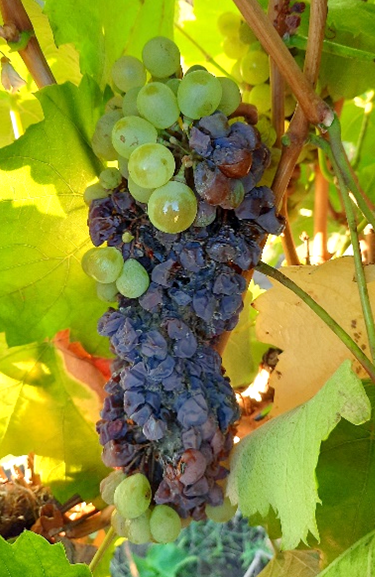
Figure 1: Botrytized bunch (Source: Bene, 2022)
The state of the aszú base wine samples is the so-called raw aszú state in the technology (Figure 2.), which means the state after fermentation and subsequent stopping, when they have not yet been barrel-aged and no wine technological intervention other than sulphurisation has taken place.
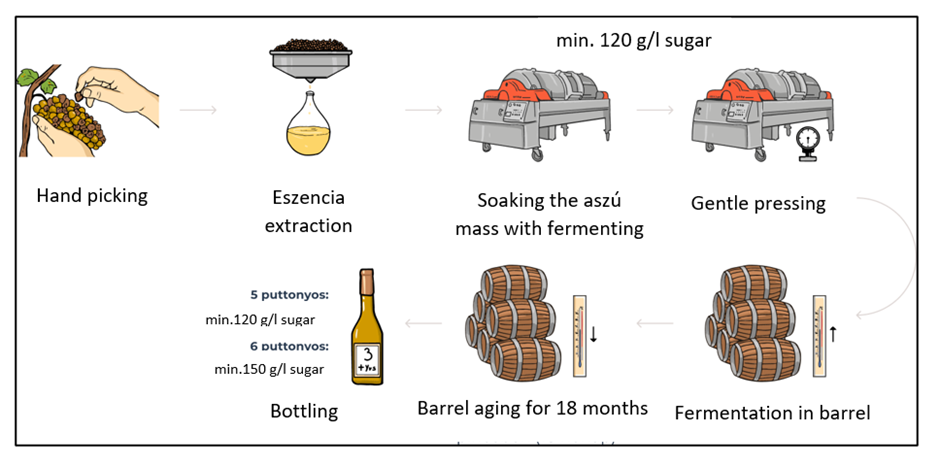
Figure 2. Aszú making process (Source: https://www.bor.hu)
2.2 Wine profiling
Examination of chemical composition was carried out with analysis (NMR - Nuclear Magnetic Resonance) in Diagnosticum Zrt. laboratory, Szerencs. H NMR Technique (Godelmann et al.,2013): 1H NMR (proton nuclear magnetic resonance) spectra acquisitions were performed on a 400 MHz spectrometer (Bruker Avance) and a magnet Bruker Ascend TM 400 MHz equipment with 2H "lock" channel and z gradient at a frequency of 400.13 MHz and 26.85 °C. The data analysis is performed at Bruker BioSpin GmbH (Rheinstetten, Germany) according to testing method AA-72-02-06 (Wine-Profiling 4.0.4), released on 06-Nov-2020 (DIN EN ISO/IEC 17025:2018 Accreditation Certificate D-PL-19229-01-00 of Bruker BioSpin GmbH).
2.3 Measurement of total phenols
Total polyphenol: Colorimetric Folin-Ciocalteu method by chromogenic complex according to REF984346 published by Thermo Fisher Gallery method and procedures (TSF, 2020). Method is performed at 37 °C, using 700 nm filter and calibrated with gallic acid standard. Polyphenols react in basic environment with Folin-Ciocalteau reagent optimized and modified. The chromogenic complex is proportional to the concentration of polyphenols in the sample, measured at 700 nm wavelength.
Orange Data Mining Toolbox (Demšar et al., 2013) 3.37.0 software was used for statistical analysis (ANOVA - Box Plot).
The measured values are shown in Table 2.
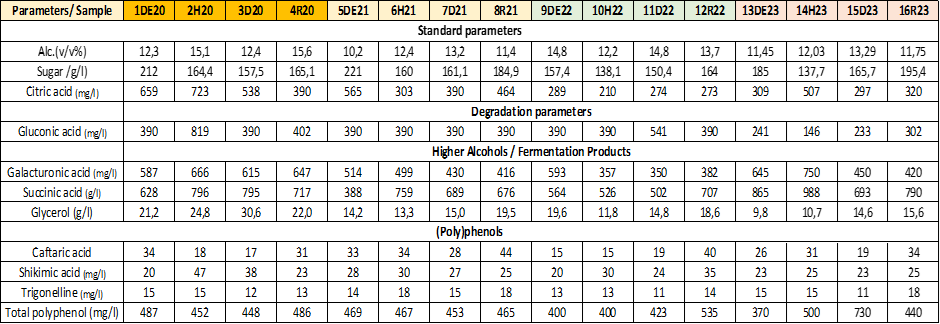
Table 2. Measured values in 2020, 2021, 2022 and 2023 vintages
The NMR instrument allows the analysis of 56 parameters, the compounds selected for the analysis of the crude ash are those that are indicators of botrytis activity according to the literature, so the following are used as a basis for comparison: sugar content, citric acid, gluconic acid, galacturonic acid, succinic acid, glycerol, phenolic acids (caftaric acid, shikimic acid, trigonelline). In all cases, the citric acid exceeds 200 mg/l, higher than that measured in normal sweet wines. For gluconic acid, it can be concluded that it is not higher than in normal sweet wines for each sample, this series of tests also confirms that this parameter is not an indicator of botrytis activity. Galacturonic acid exceeds 200 mg/l in all samples, indicating botrytis activity, as reported in the literature. Succinic acid reaches a maximum of 300 mg/l in normal sweet wines, and exceeds this value in all vintages and in all wineries in the wines tested. Glycerol levels were higher than in normal sweet white wines in all samples, exceeding 20 g/l in 4 samples (1DE20, 2H20, 3D20, 4R20).
Of the phenolic acids tested, caftaric acid shows higher values in the samples tested compared to normal sweet white wines.
The total polyphenol content is in the range of 400-500 mg/l, with 2 samples having higher values (12R22, 15D23), but not reaching 800 mg/l (Figure 3.). Botrytised raw material use increases the total polyphenol content, but not significantly and to a level that can be reduced by different derivations during maturation. The values do not vary with the vintage and the growing area (wineries), so there is no evidence that climate change is associated with increased polyphenol content.
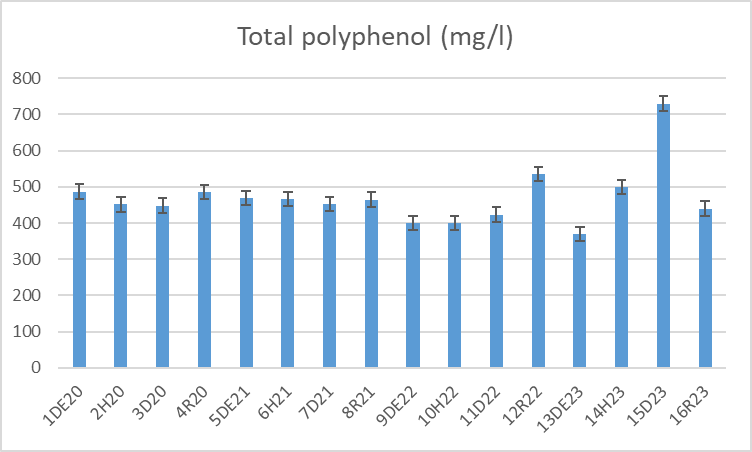
Figure 3. Measured values in the case of total polyphenol content
Based on the statistical analysis carried out, differences are shown in Table 3.
| Parameters/ Sample | p-value grouped by vintage | levels of significance | p-value grouped by winery | levels of significance |
| Alc.(v/v%) | 0.083 | - | 0.747 | - |
| Sugar /g/l) | 0.376 | - | 0.022 | * |
| Citric acid (mg/l) | 0.008 | ** | 0.817 | - |
| Gluconic acid (mg/l) | 0.040 | * | 0.893 | - |
| Galacturonic acid (mg/l) | 0.053 | - | 0.377 | - |
| Succinic acid (g/l) | 0.043 | * | 0.523 | - |
| Glycerol (g/l) | 0.002 | ** | 0.752 | - |
| Caftaric acid | 0.266 | - | 0.047 | * |
| Shikimic acid (mg/l) | 0.508 | - | 0.254 | - |
| Trigonelline (mg/l) | 0.143 | - | 0.114 | - |
Table 3. Results of statistical analysis (Analysis of variance, levels of significance: - (ns); * (P<0>
In terms of vintage, citric acid, gluconic acid, succinic acid and glycerol have the largest effect. With respect to place of production (winery), sugar and caftaric acid show significant differences.
Caftaric acid can also undergo hydrolysis in the presence of the enzyme pectinase, releasing caffeic and tartaric acids, but its involvement in certain oxidation processes is more significant. The first step in such reactions is the breakdown by polyphenol oxidase into caftaric acid ortho-quinone and water (Cheynier, 1988). If reduced glutathione (GSH) is present in the must, it is the first to react with the caftaric acid ortho-
quinone to form 2-glutathionyl caftaric acid (grape reaction product, GRP) (Salgues, 1986). GRP is colourless - its appearance does not indicate browning - and does not react with polyphenol oxidase. Its formation may therefore have the advantage of partially distracting caftaric acid ortho-quinone from reactions with other compounds leading to browning and from polyphenol oxidases (Singleton et al., 1985). However, the enzyme laccase from Botrytis cinerea, unlike polyphenol oxidase, reacts with GRP. Since caffeic acid and GRP are present in white wines in varying amounts, they can also have an effect on the taste of the wine, giving a bitter taste sensation. Based on the literature (Gawel et al., 2013), this taste is not observed at levels below 60 mg/l. In none of the samples tested did it exceed 40 mg/l, but significant differences between wineries can be detected (Figure 4.).
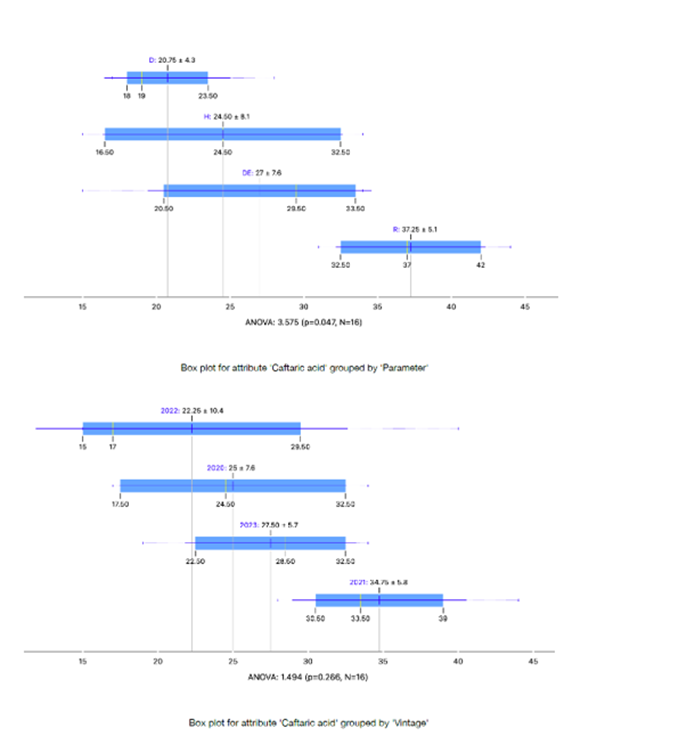
Figure 4. Statistic examination in caftaric acid composition grouped by vineyard (winery) and vintage
Importantly, it should be noted that when examining the impact of climate change, it is not possible to draw conclusions 4 years into the future. Data must be systematically collected year by year and knowledge must be systematically built up. As observed in the examined vintages, there is no evidence of an increase in polyphenol content due to climate change (400-500 mg/l). The most important phenolic acid is the caftaric acid and in none of the samples tested exceeded 40 mg/l but significant differences can be found between wineries. The glycerol content is not affected by climate change, the deviation from normal sweet wines is typical of all vintages (10-30 g/l) and is not dependent on the production area. Particular attention should be paid to the compounds citric acid, succinic acid, galacturonic acid, caftaric acid, shikimic acid, trigonelline and their quantitative ratios should be studied in relation to the different seasons, as they can be important indicators of botrytis activity. In the case of Tokaj aszú wines, the increased amount of succinic acid is noteworthy.